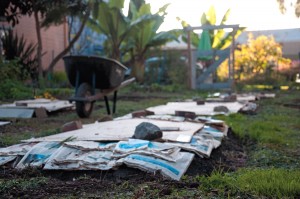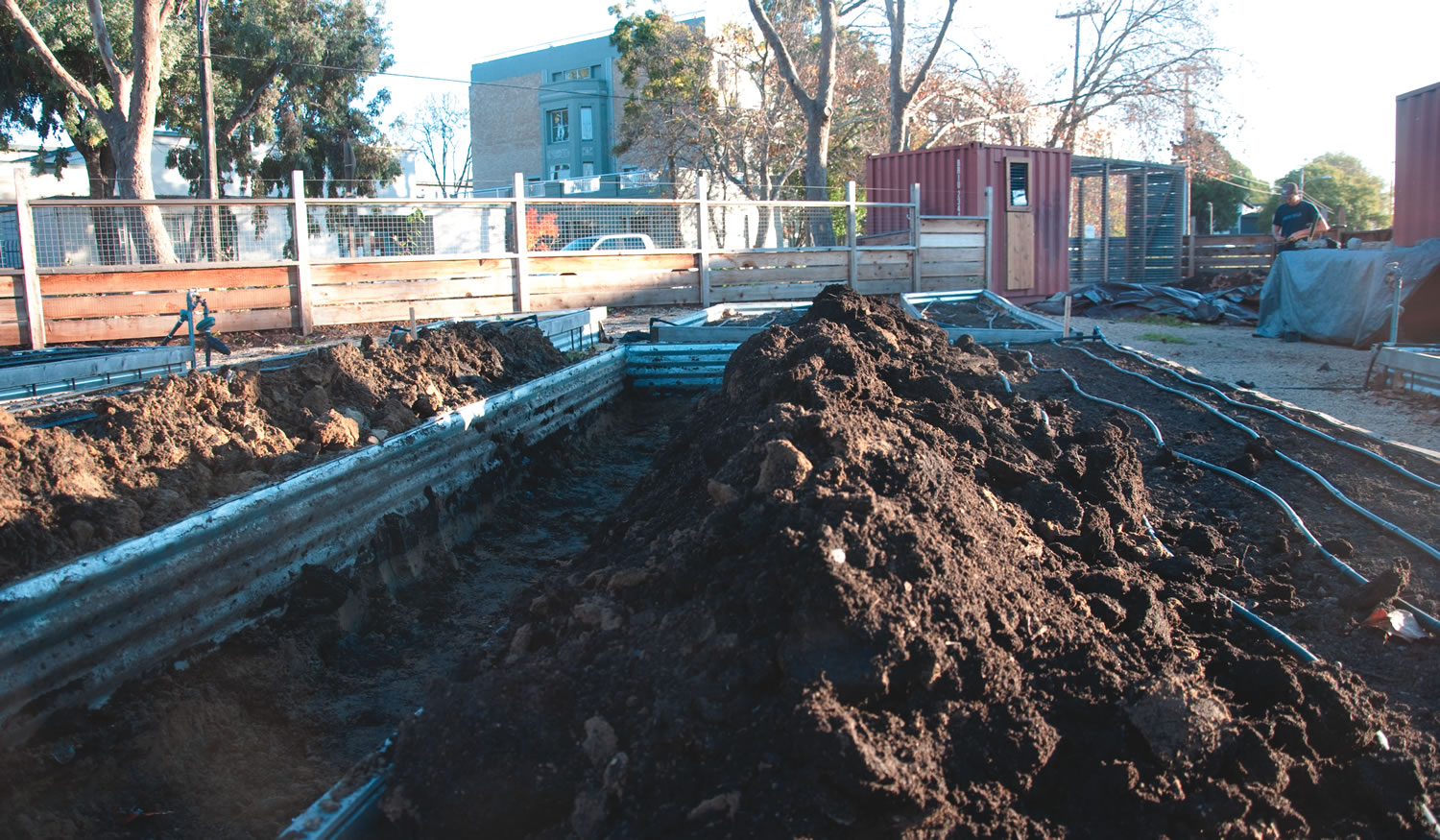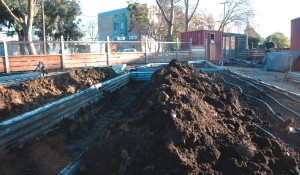Making soils productive via organics recycling is a cornerstone of meeting this California city’s goal to get 30 percent of its food from within the immediate region.
Paul Hagey
BioCycle March 2012, Vol. 53, No. 3, p. 23
The paper and cardboard will slowly dissolve with the chicken manure and leave the soil nutrient-rich and ready for a late-winter planting. When Porter bought the property 20-plus years ago, preparing the clay-dominated soil for agriculture took tremendous effort. Truckloads of biosolids from the East Bay Municipal Utility District waste-water treatment plant, which stands on the border of West Oakland a few miles away, shredded tax returns, rice hulls and worm castings, slowly built a fertile soil ready to grow food, says Porter.
About 20 blocks southeast, on a quarter-acre once-vacant city lot in West Oakland, stands Novella Carpenter’s Ghost Town Farm. Carpenter chronicled the operation, which includes the raising of ducks, rabbits and two humongous, ravenous pigs (fed largely by dumpster-diving in Oakland’s Chinatown and behind several of Berkeley’s posh restaurants) in her well-received 2009 book Farm City. “Although my holding was small — and temporary — I had come to realize,” wrote Carpenter toward the end of the book, “that urban farming wasn’t about one farm, just as a beehive isn’t about an individual bee. … Urban farms have to be added together in order to make a farm.”

The Ranch at Dogtown covers beds between harvest and the next planting with layers of cardboard, newspaper and chicken manure.
30 Percent Goal
The poverty-ridden, semiindustrial neighborhood of West Oakland, one of America’s most prominent food deserts, is just one region of Oakland’s thriving urban farming milieu. In 2006, the city made it a goal to get 30 percent of its food from within the immediate region. To accomplish this, the Oakland Mayor’s office initiated a food systems assessment and established the Oakland Food Policy Council that same year. The assessment estimates that 14,601 acres would be needed to reach the 30 percent goal.
“The next step,” said Esperanza Pallana, executive director of the 21-member Oakland Food Policy Council and an urban farmer herself, “was addressing land access.” In 2009, the council commissioned “Cultivating the Commons,” a GIS-based assessment of Oakland public land, such as city and regional parks, for its suitability for urban agriculture. The study concluded, conservatively, that there are 828 cultivatable acres on public land, the farming of which “could produce up to 5 percent of the city’s vegetable needs or 6 percent of its fruit needs.”
The study’s coauthor Nathan McClintock, a recent council member, says the one-year study was about creating a conversation around how much food Oakland could actually grow. “With 100 acres,” taking into account the city’s habit of only eating 20 percent of the produce it imports, he says, “you could grow one percent of the City’s needs.”
It’s hard, by urban agriculture’s free-form, disparate structure, to quantify how much urban farming there is in Oakland. However, the 2010 Alameda County Crop Report lists 21 certified urban farms in the county for a total of 109 acres; added to that are 215 school gardens totaling 66 acres and 19 community gardens totaling 46 acres. And McClintock estimates that there about 50 community-farmed gardens in the city.
The food policy council is also working on renegotiating the City of Oakland’s contract with its residential and commercial food scrap hauler Waste Management. Only 200 yards of compost comes back to Oakland now each year, says McClintock. With an organized municipal organic waste system, says council member Chris Waters, the city could retain more food scraps for composting. According to a 2006 Oakland Food System Assessment, food waste represents 24 percent of all single-family waste and 15.4 percent of commercial waste in the city. If all this were composted, it would result in enough compost for 120 community gardens, according to the study.
Oakland’s Department of Planning and Zoning is currently working on a local food ordinance that will recommend urban farming best practices for the city and outline policies of a city farming system and its attendant production, processing, distribution, consumption and retail, and waste management. “We’re looking at Oakland as a minifood system,” says Heather Kline, a planner in the department. Right now, the city’s addressing animal husbandry, she says, which has become a popular farming practice in Oakland.
Overall, adds Kline, Oakland is assessing urban farm management. “How do you address soil testing, fertilizers and creeks, noise and odor and good management practices around that? Where should the compost bins be? How many? Should there be different kinds?” The ordinance will address some of these items, she says, which the Oakland City Council will consider sometime mid-2012.
Soil And Hard Work
A tangle of worms, in various shades of red, writhe in Max Cadji’s palm above an open worm bin at People’s Grocery’s community garden at the California Hotel, a low-income residence in West Oakland. Cadji manages the hotel garden for People’s Grocery, a West Oakland food equity organization. The worms feed on spent coffee grounds and mushroom blocks from the Berkeley-based oyster mushroom business Back to the Roots and on food scraps gathered from two West Oakland grocery stores.
Cadji says that People’s Grocery gets about 700 pounds of spent coffee grounds and mushroom blocks along with 70 pounds of food scraps every other week. The worm castings make rich soil for the farm, and the worms are sold for about $20/pound to area businesses. He estimates that about 70 pounds of produce are harvested each week from the garden.
Several community groups and multiple individuals like Kathryn Porter farm in Oakland. “We’re in a whole ecosystem,” says City Slicker Farms executive director Barbara Finnin. When City Slicker Farms, an urban agriculture collective that now operates seven urban farms in Oakland began in 2001, the organization used bicycle rickshaws to pick up food scraps for composting from neighborhood residences. The organization now restricts food scrap harvesting to the two produce grocery stores in West Oakland.
In 2010, City Slicker Farms recycled 22 tons of organic waste, including horse manure, which became about 11 tons of compost, Finnin says. However, the organization is transitioning to horse manure as raw material for compost, because rats were becoming an issue. At one of the organization’s small farm sites at Fitzgerald Park, which lies at the base of a local highway, farm apprentice Kevin Dole points to the compost bins, now full of hay and chicken manure. When they held food scraps, he says, “every time we’d go to the compost bin, there’d be a giant rat.”
When asked about the limits of urban farming, Finnin cites land access as being really difficult. In 2010, City Slicker Farms, one of the larger of Oakland’s farmers, produced over 9,600 pounds of produce on 21,569 square feet spread over its seven farm sites. It also assisted West Oakland residents grow a total of about 24,000 pounds in about 100 backyards through the organization’s Backyard Garden Program, which helps place small raised food gardens in interested West Oakland residents’ backyards. There are about 30,000 residents in West Oakland, and the average person eats about 300 to 400 pounds of produce a year, explains Finnin. “We’re just not growing enough,” but she adds that there’s great promise for urban agriculture. “There’s a wealth of resources for farming in a city,” says Finnin, but “it’s hard work.”
Paul Hagey is a freelance writer based in Oakland, California.












